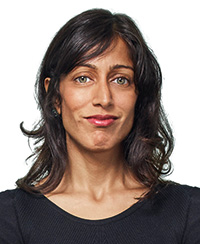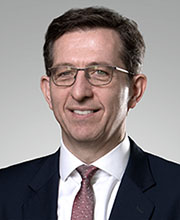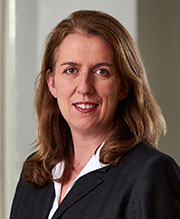Global trade disputes underpin how multi-asset funds are positioning themselves between equities and bonds, finds Alex Rolandi.
Columbia Threadneedle Investments’ Global Multi Asset Income Fund is holding more fixed income than equities for the first time in five years, in a sign of how some similar funds are adopting a cautious stance as central banks work to avoid recession.
Maya Bhandari (pictured below), multi-asset portfolio manager at the firm, says markets are “in fragile equilibrium”. Central banks are easing policy enough to avert a recession, she notes, “but are not able to raise inflation such that interest rates might ultimately need to rise again”.
 Although bonds and equities have delivered punchy year-to-date returns, fund managers see factors such as trade wars contributing to uncertainty.
Although bonds and equities have delivered punchy year-to-date returns, fund managers see factors such as trade wars contributing to uncertainty.
“As such, we have been turning more cautious over the course of the year, lowering equity allocations in favour of low-duration European corporate credit over the second and third quarters and reducing portfolio volatility,” says Bhandari.
“The great thing about bonds is you are shown what you will get paid. Give or take a little, today’s yield is broadly the return you lock in.
“With rates ultra-low across European government bonds, and almost the entire German sovereign curve trading with a negative yield, for example, investors are locking in guaranteed loss or mediocre single-digit returns if these bonds are held to maturity.”
David Vickers, managing director at Russell Investments, says despite “a very constructive year” for growth assets – including a 20% rally in global equities – burgeoning macroeconomic risks mean that the firm has also reduced exposure to equities in recent weeks, “meaningfully” in fact. The portfolio has opted for more defensive asset classes like government bonds, even cash. But broader demand for these assets has also engendered more expensive valuations.
“Consequently, we are taking advantage of optionality – specifically put, options for downside protection, which are still attractively priced relative to history. Additionally, cash should also be viewed favourably in a world of few compelling opportunities. Cash provides us with the option to deploy money opportunistically in the future at more favourable prices,” he adds.
Difficult times ahead At Kames Capital, multi-asset portfolios remain mainly in risk assets, says Vincent McEntegart (pictured right), co-manager of the Kames Global Diversified Income Fund.
At Kames Capital, multi-asset portfolios remain mainly in risk assets, says Vincent McEntegart (pictured right), co-manager of the Kames Global Diversified Income Fund.
He adds that he expects returns on most asset classes over the next few years to be modest relative to recent history, so positioning means more corporate bonds (preferably shorter-dated), a trimmed equity risk and more cash.
“Growth is scarce, so growth equities are relatively expensive. Value equities are cheap but lacking a catalyst to re-rate. We have trimmed our equity allocation but remain invested where dividend yield and growth are reasonably priced,” says McEntegart.
The fund’s cash allocation is higher than normal. “We are patient and willing to wait for better entry points to acquire attractive assets.”
The fact that $17 trillion (€15.6 trillion) of bonds are trading on negative yields suggests difficult times ahead, with slowing economic growth, he adds. He does not foresee a global recession, but thinks today’s geopolitical tensions mean investors are operating in a new paradigm.
“Global trade disputes are a relatively new theme for investors to grapple with and investors should be more cautious than usual about relying on point forecasts,” he says.
Kames’ top-down macro analysis, coupled with bottom-up individual security, “enables us to identify attractive individual opportunities irrespective of the macro outlook”, he adds.
Overall risk levels are at the lower end of the normal range, says McEntegart, reflecting a cautious near-term outlook.
Alternative opportunities
Across the board, various firms believe returns from equity markets will be low in the coming years. Aberdeen Standard Investments also expects lower returns from bonds due to reduced bond yields.
The firm is comfortable with its relatively modest exposure to equities and has negligible exposure to traditional corporate credit, according to investment director Sean Flanagan.
“We therefore strongly believe that it is important to look further afield when building a portfolio that is set to perform well over the coming years,” he tells Funds Europe.
“Local currency emerging market bonds have delivered strong performance over the past 12 months, both in the equity market sell-off in the fourth quarter of 2018 and in the equity market rally this year.
“Yields, and consequently expected returns, are lower but we still see the asset class as attractive, especially relative to the low returns available on cash and developed market bonds. Asset-backed securities continue to offer significant attractions both in absolute terms and relative to corporate bonds with significantly higher return prospects for similar levels of risk.”
The fund manager is seeing “attractive opportunities” in a number of alternative and non-traditional asset classes such as social and renewable infrastructure, healthcare royalties and real asset leasing.
Caution warranted
For German fund manager DWS, caution is warranted. The firm predicts low-single-digit return potential for equities, with returns primarily coming from dividends.
It would not be wise to focus on equities because alternatives are unconvincing, said CIO Stefan Kreuzkamp as the company published its quarterly forecast in September.
“Now that positive surprises from the central banks are hardly possible, we believe only an improvement in broad macroeconomic data is likely to increase the price potential of equities again,” he said.
In bonds, DWS has lowered target yields compared to the previous quarter and is not ruling out further periods of falling yields. It foresees negative yields across the fixed income field.
“At the moment, bond investors have little choice but to put their money into assets which still offer positive yields at an acceptable level of risk. In our view, these are investment-grade corporate bonds and long-dated US government bonds. Selectively, we also like emerging market bonds,” said Kreuzkamp in his quarterly CIO view.
The economy may look good now, he contended, but the outlook does not. “Many leading indicators paint a gloomy picture, yet services and consumption remain strong. The signals from the bond market are troubling – and political risks appear to be growing too. We remain cautious.”
“More yield in equities”
US fund manager Capital Group’s “plain vanilla, straightforward” Global Allocation Fund is mostly geared towards equities. As of the end of June this year, it had 56% in equities, 36% in fixed income and 8% cash, according to investment director Julie Dickson (pictured below).
 The multi-asset fund has four balanced managers and two dedicated to fixed income.
The multi-asset fund has four balanced managers and two dedicated to fixed income.
“Because rates are falling, they’re finding more in yield in the equity markets, but they’re very aware that equity markets can be volatile, so they hold back cash to preserve a bit of that capital, that risk in the portfolio,” Dickson says.
Long-term investing, though, means less need for reacting to short-term cycles, she adds.
“Everything we do at Capital has the long term in mind. This fund is not a short-term tactical asset allocation fund. It does not make use of dynamics or derivative overlays of any kind to make short-term asset allocation decisions.”
The company does not have an in-house view when it comes to market forecasts. Each portfolio manager has their own way of investing and their own predictions.
“It’s impossible to predict what markets are going to do, especially when there’s so much geopolitical risk at stake,” Dickson says.
“You have a presidential election in the US next year, you’ve got Brexit in the very near term in the UK, which will have a knock-on effect in the rest of Europe. China is slowing down, other markets are growing very fast, India is doing very well. There are a number of opportunities out there.”
But, she adds: “We don’t want to try to make market predictions, we’re just trying to figure out where companies are growing. Where are they growing their assets? Where are they growing their revenues and their profits, and is it sustainable? Are they in a market dynamic that means that that growth is sustainable? Are they disruptors or are they innovators?”
According to Dickson, European companies are attractively priced with much nicer yields, meaning the fund is currently underweight the US.
Underweight on Europe
BMO Global Asset Management is another asset manager more focused on equities – but it’s leaning towards firms in the US.
Keith Balmer, product specialist in the firm’s multi-asset team, says: “Currently financing for the corporate sector is plentiful and corporate profits remain high, although margins are now declining. US consumers, the largest source of aggregate demand, have been relatively cautious and have actually been increasing their savings rate.
“The Federal Reserve has also been cutting interest rates into the slowdown, whereas typically the central bank has been raising rates into a recession. But, outside of the US, there are more serious concerns about the rest of the world economy. Global trade has stalled and manufacturing is weak.”
He describes the portfolio as having a moderately pro-risk stance and as slightly overweight equities. “This view is tempered with the recognition that we expect a continued pick-up in equity market volatility and investors should be prepared for more frequent drawdowns.” US stocks are preferred to European ones on the basis of European companies’ divergent growth profiles.
Within credit, BMO GAM is underweight high yield and overweight emerging market debt. According to Balmer, this is one of the few areas where the firm sees any value at the moment.
A popular fund category
Multi-asset funds are becoming more and more popular, according to BlackRock.
“This is in response to a number of factors – the shift in responsibility of retirement provision from the state to the individual, increasing longevity, regulation and ultimately client demand to respond to these factors,” says Pollyanna Harper, who heads UK intermediary sales at BlackRock’s iShares business.
“Whilst more clients are blending index-based multi-asset funds with higher-cost active funds to manage their risk/return budget, in our view it is not about one or the other – it’s about taking a whole portfolio approach and making sure you are putting your money to work.”
©2019 funds europe





